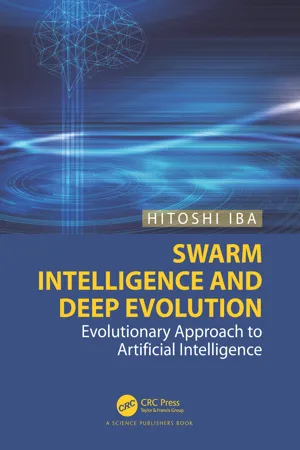
Swarm Intelligence and Deep Evolution
Evolutionary Approach to Artificial Intelligence
- 278 pages
- English
- ePUB (mobile friendly)
- Available on iOS & Android
About This Book
The book provides theoretical and practical knowledge about swarm intelligence and evolutionary computation. It describes the emerging trends in deep learning that involve the integration of swarm intelligence and evolutionary computation with deep learning, i.e., deep neuroevolution and deep swarms. The study reviews the research on network structures and hyperparameters in deep learning, and attracting attention as a new trend in AI. A part of the coverage of the book is based on the results of practical examples as well as various real-world applications. The future of AI, based on the ideas of swarm intelligence and evolution is also covered.
The book is an introductory work for researchers. Approaches to the realization of AI and the emergence of intelligence are explained, with emphasis on evolution and learning. It is designed for beginners who do not have any knowledge of algorithms or biology, and explains the basics of neural networks and deep learning in an easy-to-understand manner. As a practical exercise in neuroevolution, the book shows how to learn to drive a racing car and a helicopter using MindRender. MindRender is an AI educational software that allows the readers to create and play with VR programs, and provides a variety of examples so that the readers will be able to create and understand AI.
Frequently asked questions
Information
Chapter 1 AI: Past and Present
I have always had some disquiet about the term “artificial intelligence” and only rarely identified myself as working primarily in that area. However, I remember the first time I met Edsger Dijkstra. He was noted not only for his pioneering contributions to computer science, but also for having strong opinions and a stinging wit. He asked me what I was working on. Perhaps just to provoke a memorable exchange I said, “Al.” To that he immediately responded, “Why don’t you work on I?” [143].
1.1. AI and its History


Ever since the Swiss psychologist Jean Piagct likened children to little scientists, psychologists have compared the person in the street, young and old, to the person in the lab. (…) Natural selection, however, did not shape us to earn good grades in science class or to publish in refereed journals. It shaped us to master the local environment, and that led to discrepancies between how we naturally think and what is demanded in the academy.
Table of contents
- Cover Page
- Title Page
- Copyright Page
- Preface
- Table of Contents
- 1. AI: Past and Present
- 2. Evolutionary Theories for AI
- 3. Evolutionary Computation
- 4. Swarm Intelligence
- 5. Deep Learning and Evolution
- 6. Deep Swarms and Evolution
- 7. Emergence of Intelligence
- A. Software Packages
- References
- Indices